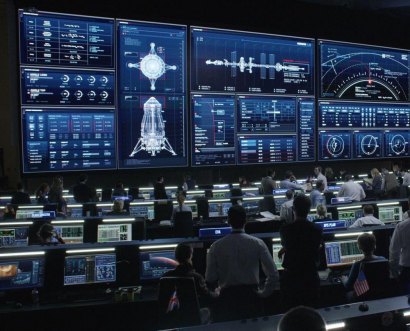Actors, scientists discuss space, "The Martian"

He was pulled aside by the director, Ridley Scott. The character would be court-martialed, Scott pointed out.
The Martian, starring Matt Damon, along with Stan, best known for his role in the Captain America movies, is to be released Oct. 2.
Stan and actress Mackenzie Davis took part in a NASA conference Sept. 15 in which they joined with astronauts and scientists to trade notes about space travel -- in the movie and for real. And, to set the record straight, "We do have astronauts that are married," said Mike Hopkins, NASA astronaut on board the International Space Station in 2013-14. "There can be some romance."
Here are some of the issues they discussed.
The trouble with spacesuits:
“The spacesuits that I’ve worn so far, they are for microgravity. Down here on Earth, they weigh 300 pounds,” said Hopkins, known by the handle "Hopper" in the astronaut program. “But obviously, when they get up in space … you are not feeling that weight. When you start talking about wearing a spacesuit on Mars, it’s definitely going to have to be a little different than what we use now, just from the weight standpoint and how we can actually walk around on the planet."
While the actors didn’t have that problem, they had another.
“When they made our astronaut suits,” Stan said, “They did not think about us going on pee breaks.”
The hours of preparation before a space walk:
“It’s five to six hours from when we start preparing to when we are actually going out the hatch,” remembered Hopkins, who was involved in space walks to repair the space station in 2013. “That’s one of the interesting parts about going out on a space walk. By the time you actually start it, you’ve already been working at least six hours. The days are long. Once you get out the hatch, the training kicks in.”
As told by Hopkins: “Holy cow, what am I doing here?"
But again, the training kicked in, and "all of the sudden, the next thing you know, you’re six hours later and you’re [back] in after completing the spacewalk.”
Adjusting to life in space:
There is no up and down. A week after he arrived at the space station, Hopkins was trying to change a lens on a microscope.
“My elbow just couldn’t get to the right orientation.”
One of the flight controllers, watching from the control room down below, made a suggestion. “Hopper, why don’t you just flip upside down?”
A lightbulb went off, Hopkins remembered. “I flipped upside down, and all of the sudden I had the right orientation and was able to change the lens out.”
The role of mission control:
The mission control crowd always appear to be sitting around staring at computer consoles and slugging soft drinks. But it can be intense, according to Pooja Jesrani, flight controller for NASA.
“My role is in charge of making sure the International Space Station rotates at the right orientation around the earth once every 90 minutes," she said, "And what I find super cool about being a flight controller is really the ability to sit on console and command a few things and the entire International Space Station, which is the size of a football field, can rotate 180 degrees."
Davis, who portrays a flight controller in the film, connected with how “being on Earth and being tethered to the livelihood of a pixelated dot on the screen, how emotional that experience is."
Looking over at Jesrani, her real-life counterpart, she asked, "Does it feel emotional for you?”
Yes, Jesrani responded. “If anything ever happens to the crew, you will have all the minds come together. …All these people are coming together to solve this problem. Mission control is really an extension of the crew on board.”
https://www.youtube.com/watch?v=ej3ioOneTy8
Related:
In Brief: "The Martian" excites space buffs
If you would like to comment, like us on Facebook and tell us what you think.

